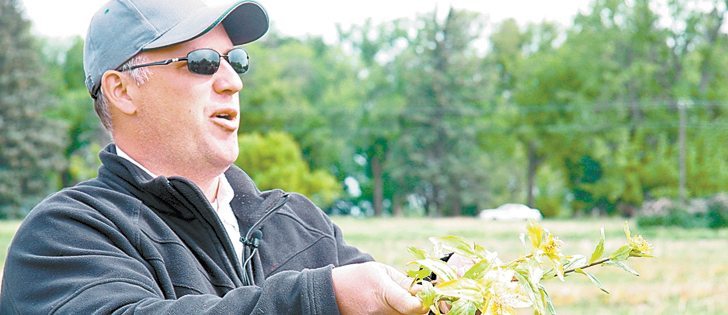Corn grazing has become a normal part of cattle production on many farms in Manitoba, but an Alberta producer has developed a different system for winter grazing.
For more than a decade, Scott Lehr of Medicine Hat, Alta., has seeded winter wheat or winter triticale in late July and has his cows on those fields throughout the winter.
Lehr, who runs a cow-calf herd and a backgrounding operation on irrigated and dry land, receives a second benefit from this approach. In certain years, he receives bonus production from the same field when he harvests silage from the winter cereal in July.
Read Also

Farming Smarter receives financial boost from Alberta government for potato research
Farming Smarter near Lethbridge got a boost to its research equipment, thanks to the Alberta government’s increase in funding for research associations.
Growing a winter cereal as a dual-purpose crop — for grazing and then silage-grain production — is a common practice in places like Texas but unusual in Western Canada.
“I’ve talked to lots of guys about it…. I don’t know if anyone is doing quite what we’re doing,” said Lehr, who grows dual-purpose winter cereals on his irrigated land.
Lehr’s unique approach came to the attention of Ken Coles, general manager of Farming Smarter, an ag research organization in Leth-bridge.
After attaining funding through a winter cereals project with Brian Beres of Agriculture Canada, Coles teamed up with Lehr to evaluate the potential of dual-purpose winter cereals.
“I think this is more of a proof of concept research project…. Rather than just look at winter wheat, we wanted to look at fall rye and winter triticale and blends of (the) three,” Coles said.
“If we are able to demonstrate, scientifically, that it’s a valid practice, then we’ll take it to (another) step … and do some extension.”
Coles wanted to know if it’s possible to graze a winter cereal throughout the winter and still get a decent grain or silage yield from the crop.
To answer that question, he fenced off a piece of Lehr’s field so cattle couldn’t graze that area. However, the cattle were allowed to graze on an identical plot next to the fenced off area.
Coles and his team duplicated the research at a site near Evansburg, Alta., west of Edmonton, to test the concept in a different growing region.
After harvesting the crop last summer, they found no difference in silage yields, whether the winter cereal was grazed or not.
“All the benefits you got from the (winter) grazing didn’t compromise the second harvest (for silage),” Coles said.
“From our limited experience, I certainly think it (grazing and silage) is feasible and especially under irrigation…. Medicine Hat is actually a fairly tough winter environment. I think it’s getting a pretty good test. If it works out in Medicine Hat, it’s going to work better in Lethbridge.”
Lehr adopted winter cereal grazing to save money and time because putting “seed in the ground and a little bit of fertilizer” is cheaper than feeding cattle hay throughout the winter.
“We don’t have enough area (land) to get them through the whole winter. We do put out hay … (but) when they’ve got lots of grazing, they don’t even touch it (the hay).”
Typically, Lehr doesn’t just seed winter wheat or triticale. He likes to add other crops to the mix.
“We take the cereal silage off in July and after that, later July to early August, we re-seed back with a winter cereal — triticale or wheat. (We) put in tillage radishes and clovers and different things.”
The cattle begin grazing in late October when the crop is about 50 centimetres high. The cattle graze until early spring.
“For us, we leave our cows in the field until calving. Which is around April 10,” Lehr said.
“We don’t have anywhere in between to put them.”
Winter cereals have failed on Lehr’s farm because the cattle graze in March and April when the crop is starting to develop, but that’s not a significant concern.
“If a guy could get them (cattle) off before the crop starts breaking dormancy… it would work a little better. You would have better winter survivability, but I don’t have that option,” he said.
“(Still) if the winter cereal doesn’t survive the winter, I’m still ahead of the game even if I do have to reseed. The amount of grazing I’m getting off of it, alone, is making it worthwhile.”
Coles and Farming Smarter will continue their research for two more years. Once they accumulate more data, the next step is evaluating the economics of the system.
“So far I’m definitely intrigued,” Coles said.
“I think (this) intensive management, on a mixed farm, could be quite profitable.”


















